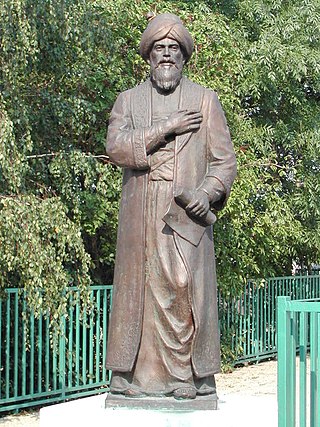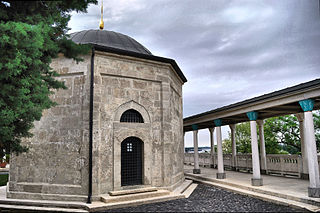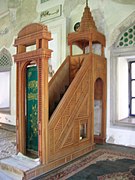
Pécs is the fifth largest city in Hungary, on the slopes of the Mecsek mountains in the country's southwest, close to the border with Croatia. It is the administrative and economic centre of Baranya County, and the seat of the Roman Catholic Diocese of Pécs.

The Bektashi Order or Bektashism is an Islamic Sufi mystic order originating in the 13th-century Ottoman Empire. It is named after the saint Haji Bektash Veli. The Bektashian community is currently led by Baba Mondi, their eighth Bektashi Dedebaba and headquartered in Tirana, Albania. Collectively, adherents of Bektashism, are called Bektashians or simply Bektashis.

Türbe refers to a Muslim mausoleum, tomb or grave often in the Turkish-speaking areas and for the mausolea of Ottoman sultans, nobles and notables. A typical türbe is located in the grounds of a mosque or complex, often endowed by the deceased. However, some are more closely integrated into surrounding buildings.

Nevşehir is a city in the Central Anatolia Region of Turkey. It is the seat of Nevşehir Province and Nevşehir District. Its population is 123,882 (2022). It is 290 km (180 mi) from the capital Ankara and lies within the historical region of Cappadocia.

The large Fatih Mosque is an Ottoman mosque off Fevzi Paşa Caddesi in the Fatih district of Istanbul, Turkey. The original mosque was constructed between 1463 and 1470 on the site of the Church of the Holy Apostles. Seriously damaged in the 1766 earthquake, it was rebuilt in 1771 to a different design. It is named after the Ottoman sultan Mehmed the Conqueror, known in Turkish as Fatih Sultan Mehmed, who conquered Constantinople in 1453.

There are an estimated 20,000 Muslims in the Czech Republic, representing 0.2% of the country's population. The growing Turkish community form the largest Muslim population in the country.

Gül Baba, also known as Jafer, was an Ottoman Bektashi dervish poet and companion of Sultan Suleiman the Magnificent who took part in a number of campaigns in Europe from the reign of Mehmed II onwards.

In 2010, there were an estimated 5,900 Muslims in Slovakia representing fewer than 0.1% of the country's population. As of October 2023, Slovakia is the only EU member state that does not have a mosque.

İbrahim Peçevi or Peçuyli İbrahim Efendi or (in Bosnian)Ibrahim Alajbegović Pečevija (1572–1650) was an Ottoman Bosnian historian-chronicler of the Ottoman Empire.

Ottoman Hungary encompassed those parts of the Kingdom of Hungary which were under the rule of the Ottoman Empire from the occupation of Buda in 1541 for more than 150 years, until the liberation of the area under Habsburg leadership (1686–1699). The territory was incorporated into the empire, under the name Macaristan. For most of its duration, Ottoman Hungary covered Southern Transdanubia and almost the entire region of the Great Hungarian Plain.

The Battle of Keresztes took place on 24–26 October 1596. It was fought between a combined Habsburg-Transylvanian force and the Ottoman Empire near the village of Mezőkeresztes in modern-day northern Hungary. The Ottomans routed the Habsburg-led army but due to their own losses were unable to exploit their victory.
Böszörmény, also Izmaelita or Hysmaelita ("Ishmaelites") or Szerecsen ("Saracens"), is a name for the Muslims who lived in the Kingdom of Hungary in the 10–13th centuries. Some of the Böszörmény probably joined the federation of the seven Magyar tribes during the 9th century, and later smaller groups of Muslims arrived in the Carpathian Basin. They were engaged in trading but some of them were employed as mercenaries by the kings of Hungary. Their rights were gradually restricted from the 11th century on, and they were coerced to accept baptism following the establishment of the Christian Kingdom of Hungary. They "disappeared" by the end of the 13th century.

The Arabati Baba Tekḱe is a tekḱe located in Tetovo, North Macedonia. The tekke was originally built in 1538 around the türbe of Sersem Ali Baba, an Ottoman dervish. In 1799, a waqf provided by Recep Paşa established the current grounds of the tekke. The finest surviving Bektashi lodge in Europe, the sprawling complex features flowered lawns, prayer rooms, dining halls, lodgings and a great marble fountain inside a wooden pavilion.
The Turks in Hungary, also referred to as Turkish Hungarians and Hungarian Turks, refers to ethnic Turks living in Hungary. The Turkish people first began to migrate predominantly from Anatolia during the Ottoman rule of Hungary (1541-1699). A second wave of Ottoman-Turkish migration occurred in the late 19th century when relations between the Ottoman Empire and the Austro-Hungarian Empire improved; most of these immigrants settled in Budapest. Moreover, there has also been a recent migration of Turks from the Republic of Turkey, as well as other post-Ottoman states.

The Downtown Candlemas Church of the Blessed Virgin Mary, formerly known as the Mosque of Pasha Qasim is a Roman Catholic church in Pécs, Hungary, which was a mosque in the 16–17th century due to the Ottoman conquest. It is one of the symbols of the city, located in the downtown, on the main square. The current building, a hundred steps in length and in width, was built by Pasha Qasim the Victorious between 1543 and 1546. The mosque was converted into a church in 1702, after Habsburg-Hungarian troops reconquered the city. The minaret was destroyed by the Jesuits in 1766. One of the largest Ottoman constructions remaining in Hungary, the building still retains many Turkish architectural characteristics.

Muftiship of Novi Sad is one of the four muftiships of the Islamic Community in Serbia. Muftiship is including territory of the Autonomous Province of Vojvodina and its seat is in Novi Sad. Administrator of the muftiship is mufti Fadil Murati.

Gül Baba's tomb (türbe) in Budapest, Hungary, is the northernmost Islamic pilgrimage site in the world. The mausoleum is located in the district of Rózsadomb on Mecset (mosque) Street, a short but steep walk from Margaret Bridge.

The Yakovalı Hasan Paşa Mosque is an early 17th-century mosque in Pécs, southern Hungary. It was constructed when the region was part of the Turkish Ottoman Empire, together with the main mosque of Pécs, the Mosque of Pasha Qasim. It was named after the local government official who commissioned the mosque, Yakovalı Hasan Paşa, or Hasan Pasha of Yakova. It is thus one of the oldest mosques existing in Hungary today, and is considered to be the most intact mosque to have survived from the Ottoman era. The mosque is still active as a Muslim place of worship, and also houses a small exhibition centre for Turkish handicraft and historical artifacts documenting Hungary's Ottoman past.

Ibrahim Pasha Mosque is an Ottoman-era mosque on the Aegean island of Rhodes, Greece. It is the oldest out of the seven mosques inside the old walled city of Rhodes, and the only one open to worship today, serving the Turkish-Muslim community of Rhodes.
































